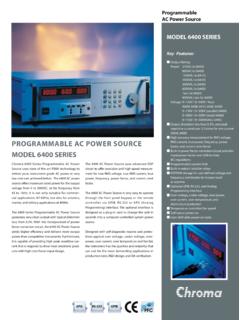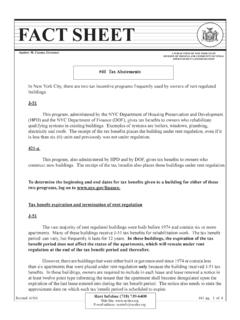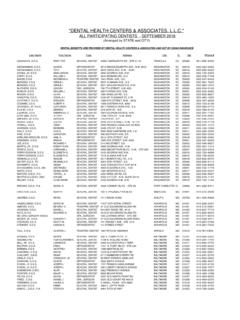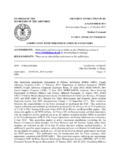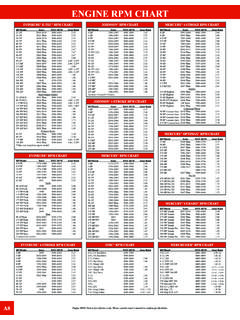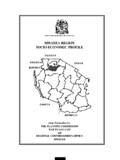Transcription of Global review of biodegradable plastics testing and standards
1 Global review of biodegradable plastics testing Markus Weber, DIN CERTCO Gesellschaft f r Konformit tsbewertung mbH (Berlin)IntroductionBesides DIN V 54900, various other standards on the testing of the compostability ofmaterials, or of products made from them, have been developed in recent years. One ofthem, for example, is the European Standard EN 13432. This standard is part of a wholeseries of standards prepared under a mandate from the EU to support the implementation ofthe Directive on Packaging and Packaging Waste (94/62/EC). In addition, ASTM standardshave been developed in the United States, ISO standards at international level, and inJapan, too, specifications on compostability have been drawn up, though no generallyaccepted Japanese Standard (JIS) has been adopted there, as yet. Accordingly, to permitthe proposed comparison between the various standards used world-wide, reference will bemade below to the GreenPla certification scheme instead of to a Japanese of these standards is now being applied by a number of certification organisations inthe testing and assessment of compostable products and materials.
2 By way of a comparisonof the individual standards or certification schemes, it is to be shown here in what respectsthey differ and where they are in agreement, before a perspective on future developments inthe harmonisation of standards and certification procedures of compostable material of standards for assessing compostabilityIn addition to the German standard DIN V 54900, the European standard EN 13432 and theAmerican standard ASTM D 6400 are also used as the basis for assessment standards are very similar in all essential respects, but differ in certain details. Thecertification scheme of GreenPla (Japan) differs more significantly in a number of points fromthe other standards referred a rule, the assessment of compostable materials and products comprises five differentparts: characterisation determination of ultimate biodegradability determination of compostability (disintegration) analysis of the quality of the compost determination of ultimate anaerobic biodegradability (not obligatory)CharacterisationAll three standards require comparable chemical tests (cf.)
3 Table 1). They differ in respectto the limit values for hazardous substances (cf. Table 2). Both EN 13432 and ASTM D 6400dispense with an analysis of the nutrients (N, P, K, Mg, Ca). Assessment as specified in thecertification scheme of GreenPla includes ecotoxicity testing from the initial material stageon. Such tests are not provided for in the other standards until the quality of the composts isto be 1 Overview of characterisation specificationsStandardDIN V 54900 EN 13432 ASTM D 6400 GreenPlaDetailedspecificationsDIN V 54900-1 Clauses 5,6 and 7EN 13432,Subclause Annex D 6400,Subclause CFR andidentification ofconstituentsOrganicconstituents notless than 50 %Volatile solidscontent not lessthan 50 %-Organicconstituents notless than 50 %GeneralcharacterisationTOCTCV olatile solidsAsh contentElemental analysis(C, H, O, S, N)TOCT otal dry solidsVolatile solids--NutrientsN, P, K, Mg, Ca--Hazardoussubstances -inorganicZn, Cu, Ni, Cd, Pb,Hg, CrZn, Cu, Ni, Cd,Pb, Hg, Cr, Mo,Se, As, FZn, Cu, Ni, Cd,Pb, Hg, Se, AsZn, Cu, Ni, Cd, Pb,Hg, Cr, Mo, Se, As,FHazardoussubstances organicPCB, PCDD/F---Ecotoxicity test---OECD Guidel.
4 201 OECD Guidel. 202 OECD Guidel. 203 Oral Acute ToxicityTests (Rats)Specification of the limit values in all three standards follows the same basic approach. Therespective legal limit values for soil, as specified in the German bio-waste regulation orin US law in the "Codes of Federal Regulation" (40 CFR ) are taken as the basis andthen increased by a certain percentage value, in the case of ASTM D 6400 by 50 %.The limit values in EN 13432 are all less stringent than those in DIN V 54900-1. For PCB andPCDD/F there are no limit values at all in EN 13432, though these are not defined in DIN V54900, either. On the other hand, other hazardous substances have been included in thescope of testing (cf. Table 2). ASTM D 6400 permits the highest concentrations of 2 Differences in limit values between EN 13432, DIN V 54900-1, and ASTM D 6400 DIN V 54900-1EN 13432 ASTM D 6400 GreenPlaLimit values [mg/kg] Limit values [mg/kg] Limit values [mg/kg] Limit values [mg/kg]Zn1001501400150Cu235075037,5Ni152 521025Cd0,30,5170,5Pb305015050Hg0,30,58, 50,5Cr3050-50Mo-1-1Se-0,75500,75As-520,5 3,5F-100-100 PCBNot defined---PCDD/F Not defined---Determination of ultimate biodegradabilityThe criteria for biodegradability under laboratory conditions as specified in EN 13432, DIN V54900-2 and ASTM D 6400 are similar, as Table 3 shows.
5 DIN V 54900-2 specifies thathomopolymers must have achieved a level of degradation of 60 % after six months, andcopolymers, a level of degradation of 90 %. The same values are specified forhomopolymers and copolymers in ASTM D 6400, but this level of degradation need only beachieved in comparison to a known reference material and not absolutely. EN 13432specifies in all cases that the percentage of biodegradation shall be 90 % in respect to areference substance. The test duration is not to exceed 6 months. ASTM D 6400 permits thetest duration to be extended to one year if radiolabelled test substances are V 54900 and EN 13432 agree in that the biodegradability must be determined for eachsignificant organic constituent (> 1%) and that the total organic content must amount to notless than 50 %. An equivalent specification is not made in ASTM D exemption is made in EN 13432 for chemically unmodified materials and constituents ofnatural origin (wood, wood fibre, cotton, starch, paper pulp or jute).
6 These are accepted asbeing biodegradable without further testing . They must, however, be chemicallycharacterised and meet the criteria for disintegration and compost the GreenPla certification scheme, as in EN 13432, reference is made in respect to testingto various ISO standards and to the OECD Guideline 301. No specification is made,however, with regard to a time limit for the compostability test, and the minimum level ofdegradation is only 60 % instead of 90 %.Table 3 Overview of criteria for assessing biodegradabilityStandardDIN V 54900EN 13432 ASTM D 6400 GreenPlaDIN V 54900-2 Method 1:Determination of thebiochemical oxygendemand in a closedrespirometerISO 14851-JIS K 6950(ISO 14851)Test methodDIN V 54900-2 Method 2:Determination of theevolved carbondioxide in anaqueous mediumISO 14852-JIS K 6951(ISO 14852)DIN V 54900-2 Method 3:Determination of theevolved carbondioxide in compostISO 14855 ASTM D 6002 ASTM D 5338 JIS K 6953(ISO 14855)Test objectConstituents presentin a concentration ofmore than 1 % (Nomore than 3 %without determinedbiodegradability)Constituentsp resent in aconcentration ofmore than 1 % (Nomore than 5 %without determinedbiodegradability)Constituentsp resent in aconcentration ofmore than 1 %Constituentspresent in aconcentration ofmore than 1 % (Nomore than 5 %without determinedbiodegradability)Maximum duration6 months6 months6 months(1 year forradiolabelledmaterials)(Not specified in theGreenPlacertificationscheme)Required level ofdegradation60 %(homopolymers) or90 % (copolymers)90 % of the value ofa suitable referencematerial60 %(homopolymers) or90 % (copolymers)of the value of asuitable referencematerial60 % of the value ofa suitable referencematerialDetermination of compostability (disintegration)
7 DIN V 54900-3 specifies both pilot-scale and full-scale testing , whereas EN 13432 specifiesonly the pilot-scale test as obligatory. The standard EN 13432 indicates the criteria of asuccessful test under item , but does not prescribe a specific method for the practicalperformance of the test. ASTM D 6400 does not specify a particular method, either. DIN V54900-3 further specifies the performance of a compostability test with a considerably higherconcentration of compostable materials (ecotoxicity test) that is not prescribed in the otherstandards. The GreenPla certification scheme makes no provision for compostability 4 Overview of disintegration testsStandardDIN V 54900EN 13432 ASTM D 6400 DIN V 54900-3 Pilot-scale testing underoptimised processconditionsNo method obligatoryASTM D 6400,Subclause D 6002-96,Subclause methodDIN V 54900-3 Full-scale testing underreal conditionsNo method voluntary-Maximum duration 12 weeks (pilot-scale)10-15 weeks (full-scale)12 weeks5 weeks (may beextended)Specified level ofdegradation90 % of the sievefraction > 2 mm90 % of the sieve fraction> 2 mm90 % of the sievefraction > 2 mmAnalysis of quality of compostsFor the analysis of the quality of the composts, various ecotoxicity tests are referenced.
8 DINV 54900 further comprises a visual inspection (content of unwanted residues). In the case ofEN 13432 a more precise chemical characterisation of the compost is also to be conductedto determine, among other things, the nutrient content, which in DIN V 54900 is incorporatedin the chemical characterisation of the 5 Methods of determining compost qualityStandardDIN V 54900EN 13432 ASTM D 6400 Ecotoxicity test withsummer barley tosubclause of E DIN54900-4 (or inaccordance with LAGA-Merkblatt M10 E )Ecotoxicity test with notless than two types ofplants. In accordance withOECD Guideline test withcress and at least twoother types of plant isto be conducted inaccordance withOECD Guideline 208No obviouslydistinguishableunwanted residues--No loss of quality incomparison with blankcompost (of samematurity)--Test method-Chemical characterisationof the compost:Volumetric weight, totaldry solids, volatile solids,salt content, pH-valueNutrient content (N, NH4-N, P, Mg, Ca)- Determination of ultimate anaerobic biodegradabilityTesting of ultimate anaerobic biodegradability is an option in testing to EN 13432.
9 Ifperformed, tests may be undertaken in accordance with ISO/DIS 15985, ISO 11734 orISO/DIS 14853. Within 2 months, a percentage of biodegradation of not less than 50 % shallthen be of the compostability standards in various certification systemsfor compostable materials and productsStatus quoThe standards referred to in the previous section are used by various organisations offeringworld-wide certification schemes for compostable materials. Table 6 gives an overview ofthese. This table, which makes no claim to be complete, clearly indicates the large number ofstandards and procedures currently applied. In addition, all organisations implement variousspecial arrangements which are not described 6 Certification bodies and schemes for compostable materialsOrganisation(location)DIN CERTCOIBAW(Germany)AIB Vin otte(Belgium)BiodegradableProducts Institute/ US CompostingCouncil(USA)J telaito-syhdistys(Finland)BiodegradableP lastics Society(Japan)LogoChemicalcharacteri-sat ionDIN V 54900orEN 13432orASTM D 6400EN 13432 ASTM D 6400EN 13432 GreenPlacertification schemeDeterminationof ultimatebiodegrada-bilityDIN V 54900orEN 13432orASTM D 6400EN 13432 ISO 14851 ISO 14852 ASTM D 6400EN 13432 ISO 14851 ISO 14852 OECD 301 CJIS K 6950(ISO 14851)JIS K 6951 ISO 14855 ISO 14855(ISO 14852)JIS K 6953(ISO 14855)Determinationofcompostability(disi ntegration)
10 DIN V 54900orEN 13432orASTM D 6400EN 13432 ASTM D 6400EN 13432-CompostqualityDIN V 54900orEN 13432orASTM D 6400EN 13432 ASTM D 6400EN 13432-Additionaltests-Mechanicalstabilit y of bio-waste bags---Relevance of EN 13432 Especially important for the European market is the adoption of the European standard EN13432 by the European Commission. Products legally manufactured or marketed in onecountry of the European Union should in principle move freely throughout the community, ifsuch products meet equivalent levels of safety. To achieve this aim a new regulatorytechnique and strategy was laid down by the Council Resolution of 1985 on the NewApproach to technical harmonisation and standardisation, which established the followingprinciples: Legislative harmonisation is limited to essential requirements that products placed on theCommunity market must meet, if they are to benefit from free movement within theCommunity.

